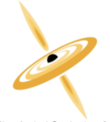Speaker
Description
Besides giant planets, rings were discovered around three different small bodies in the Solar System: in 2013, around the Centaur (101999) Chariklo [1]; in 2017, around the dwarf planet (136108) Haumea [2]; in 2023, two rings outside the Roche limit were detected around the Trans-Neptunian Object (50000) Quaoar [3, 4]. In addition to these confirmed ring systems, observations of stellar occultations by the Centaur (2060) Chiron, which occurred in the 1990s and 2011, revealed the presence of additional material around this object. These additional structures were interpreted as collimated jets of material expelled by the nucleus, spherical shells, and rings [5, 6, 7, 8]. To understand the nature of this material and determine the physical properties of Chiron itself, new stellar occultations were observed in 2018, 2019, 2022, and 2023. The 2018 observation determined detection limits for the structures around Chiron. In 2019, a multi-chord detection allowed the determination of the equatorial radius of $126\pm22$ km and its volume [9]. In 2022, observations with large telescopes detected material around Chiron, which is consistent with an extended disk with approximately 580 km and two concentrations of material at distances of $325\pm16$ km and $423\pm11$ km from the center of Chiron, consistent with rings [10]. The last observed occultation, on September 10, 2023, had positive observations from 9 different sites; among them, we have the Perklin & Elmer 1.6 m telescope at Pico dos Dias observatory from the Laboratório Nacional de Astrofísica (LNA). This telescope has obtained one of the best signal-to-noise ratio and cadence light curves. The data is under analysis but has already shown unprecedented characteristics of the surrounding structures. In this work, we will present the analysis of these structures over time and some details of the results recently obtained.

